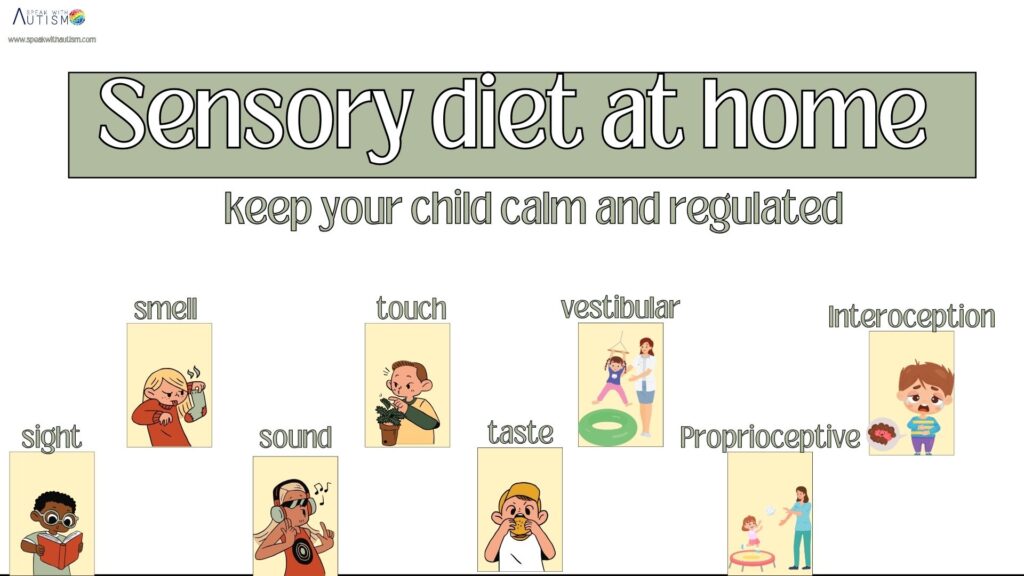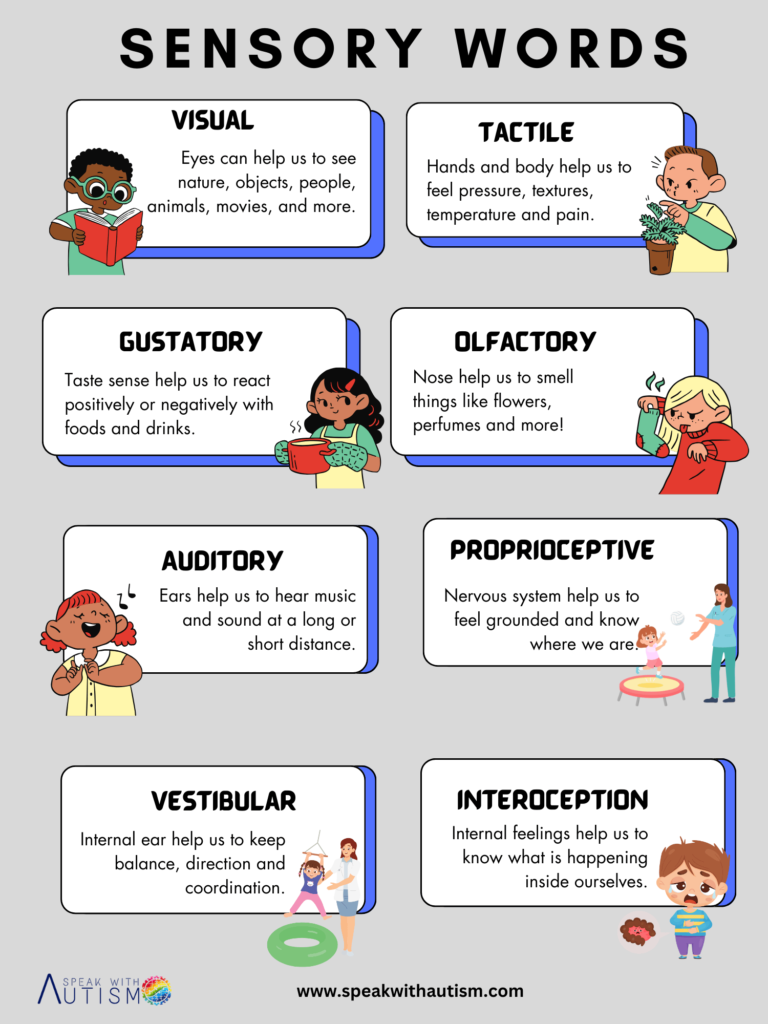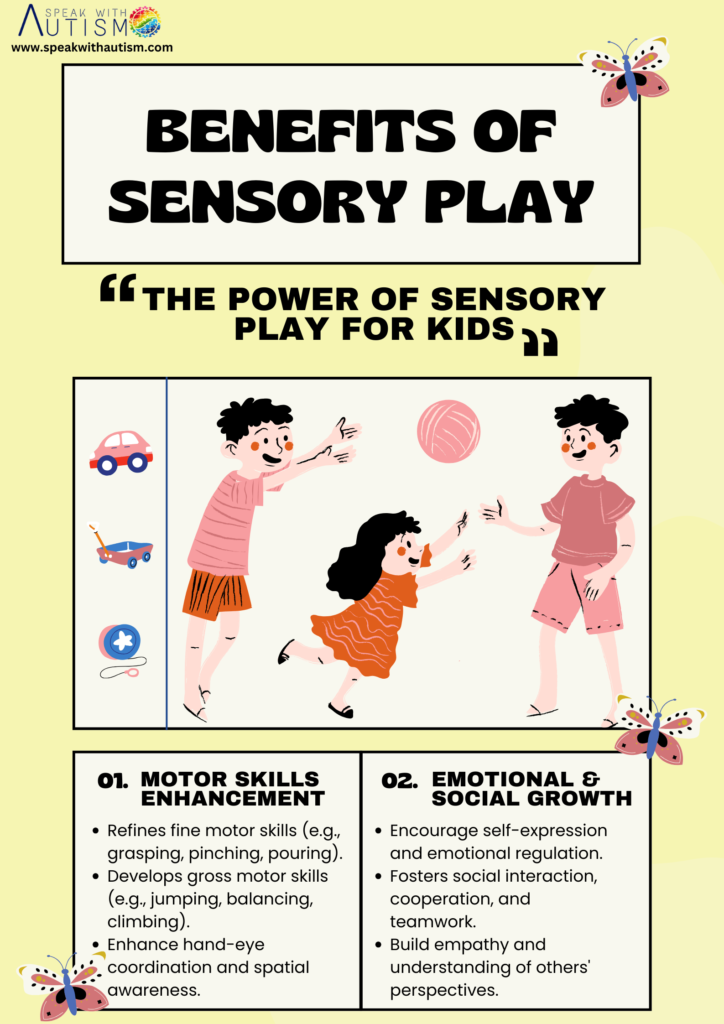A Sensory diet at home is about “feeding” our senses with what they need so that the body and mind can function optimally. For children, especially those with autism or sensory processing challenges, a sensory diet can be an important part of their daily routine. This diet is not related to food and drink, but to everyday activities and inputs that help children feel regulated and calm.

Table of Contents
Importance of a Sensory diet at home

- Regulation: Helps the child to control their energy and emotions.
- Calmness: Useful for calming an over-excited child or alerting a less active child.
- Focus: Activities that are part of a sensory diet increase a child’s attention and learning ability.
What can be included in a sensory diet?
A sensory diet is different for each child’s needs. An occupational therapist can help create it. Nevertheless, below are some common and effective activities:
1. Proprioceptive input (activities that put pressure on muscles and joints)
- Lifting heavy objects: Let the child help lift grocery bags or bring in plates.
- Pulling and pushing activities: like opening/closing doors, and sliding chairs.
- Sweeping or doing small dusting work while sitting in a squat position.
- Wringing wet clothes and hanging them out to dry.
2. Vestibular input (activating balance and movement systems)
- Swinging on a swing.
- Climbing a jungle-gym.
- Running or jumping.
- Using moving toys like a spinning top.
3. Tactile input (activations involving touch and texture)
- Let the child play with different textures like socks stuffed with rice, slime, or clay.
- Touching and working with wet or dry clothes.
- Gentle massage of hands or feet.
- Apply gentle pressure to the child while applying cream in the morning.
4. Oral motor input
- Drinking water through a straw.
- Chewing hard candy or using chew toys.
- Wash face with cold or warm water.
- Brush teeth with a Vibrator brush to help in strengthening oral muscles.
5. Involving in everyday tasks
- Help in serving food.
- Mashing potatoes.
- Cleaning or keeping things in the right place.
- Participating in small tasks, like helping in washing utensils.
How to include sensory diet in the routine?

Early morning
- Lift the child from a heavy blanket.
- Use a vibrating toothbrush.
- Bath with cold or lukewarm water for tactile input.
Before going to school
- Give a gentle massage.
- Ask to walk a little while carrying a heavy bag.
- Give children movement breaks with activities.
In the evening
- Playful activities like running, swinging on a swing.
- Participation in household chores, like cleaning the table.
Before bedtime
- Use a massage or a heavy blanket in the bedtime routine.
- Play calming music.
- Calm the child with a book reading.
How to make a sensory diet effective?

- Be well-planned: Make the diet according to the child’s needs likes and dislikes.
- Build slowly: Start with simple activities in the beginning and gradually make them challenging.
- Make it fun: Introduce activities like a game.
- Consult a therapist: Contact an occupational therapist for proper guidance and planning.
Conclusion
The sensory diet is a powerful way to help children develop and balance. It promotes their behavior, focus, and self-reliance. Spend time with your child, understand their needs, and give them love and support. Remember, with the right planning and patience you can better empower your child.
Frequently Asked Questions
Which children have sensory issues?
Sensory issues can occur in many children, but they are especially common in those diagnosed with Autism Spectrum Disorder (ASD), Attention Deficit Hyperactivity Disorder (ADHD), or Sensory Processing Disorder (SPD). These issues mean that a child either feels certain sensory inputs (like sound, light, touch, smell, or taste) too intensely or does not respond to them at all.
How many types of sensory issues?
There are two main types of sensory issues, based on how a child processes sensory information. These are often categorized as sensory modulation difficulties:
1. Hypersensitivity
2. Hyposensitivity
Hypersensitivity, or sensory defensiveness, occurs when children overreact to sensory input such as light, sound, or texture. This type of reaction is common in children with autism, especially those who also have sensory processing disorder.
Hyposensitivity occurs when children underreact to sensory input such as light, sound, or texture. Hyposensitivity children seek more stimulation; they spin objects, hop and jump, and throw balls repeatedly, these children often enjoy the sound of their own voices. This type of reaction is common in children with autism, especially those who also have sensory processing disorder.
